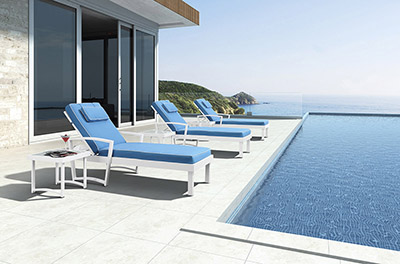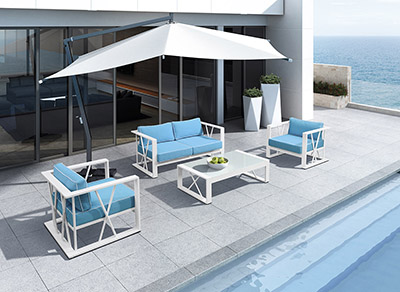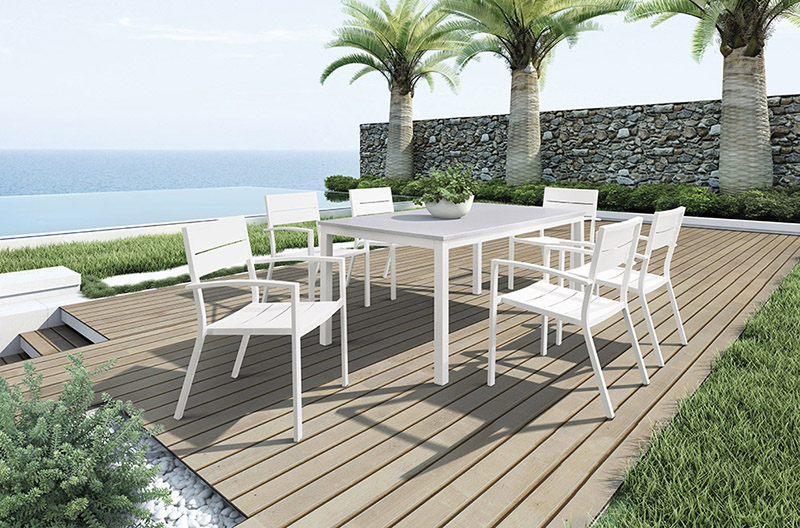Outdoor aluminum
furniture is suit for outdoor patio usage for a long time. The material is
1.2mm , 1.5mm or 2.0mm thickness aluminum frame with powder-coated.
Secure and
comfortable structure, simple design but elegance, is popular option for
customer. Aluminum frame is welded and polished in meticulous style. Gently angled backs and wide arms
encourage restful lounging. The industry`s best high-performing fabrics encase
the thick, double-wrapped foam cushions.
·
Traditional forms with a spacious, inviting scale
·
Rust-resistant powder-coated aluminum frame.
·
Comfortable 30 density cushion foam.
·
Secure tempered glass for dining table and coffee
table.
·
Waterproof fabric for cushions.
Outdoor
aluminum furniture with high quality and long time guaranty.
If
you have any questions, please contact with us directly. Outdoor Aluminum
Furniture are produced by Golden Eagle Outdoor Furniture Co.,ltd with High
Quality and Good Appearance. Welcome you to visit our Factory for any inquiry,
please send mail directly to us.
According to the paper performance to determine the number of screens commonly used screen number 80,100,120,133,150,175,200,300lpi, etc., in the actual choice, the paper's performance is an important factor. The surface properties such as the smoothness and roughness of the paper determine that they have different requirements for the number of screens. Coated paper or high-calendered white paperboard has a high surface smoothness and can reproduce finer dots. Therefore, the number of screen lines is relatively high, generally set at 175 to 300 lpi. The surface of offset paper is thicker than coated paper, and the number of screens can be 120. ~150lpi; Newsprint surface is rougher, too small dots will form broken edges, or completely fall in the sunken place, so you should use a larger dot printing, the number of screen lines can be between 80 ~ 33lpi .
According to the performance of the paper, it is determined that the black/white field is at the highlight of the printed image, which is generally not printed in a highlight area of ​​3% to 5%, that is, the highlight portion of the print is formed by the color of the paper. If the whiteness of the paper is different, the brightness and saturation of the color at the main light of the screen will be affected, thereby affecting the color contrast of the screen. Similarly, the texture of the paper is also very relevant. The newsprint is a porous material. The ink is easily absorbed by the fibers, resulting in a high degree of light scattering on the printing surface. The printing density is reduced, the dark areas are not black, and smooth, coated. Paper, ink is absorbed on the surface, and light is scattered very little, making the darker tone darker.
The poor printing glossiness of newsprint has a direct impact on the drift of printing ink color; the surface has low whiteness and small print contrast; the smoothness is low, and the ink diffusion is strong, so that the number of good newsprint screens does not exceed 133 lpi. In view of these characteristics, the black/white field calibration value, white field can be small area network (C=0%, M=0%, Y=0%, K=0%), black field can be calibrated as C=62 %, M=Y=56%, K=75%, the total amount of ink overprint is also smaller, 250.
Coated paper surface has good smoothness, whiteness, and light reflection ability. The ink printed on the coated paper has small diffusion, dot type is good, the dot enlargement rate can be controlled at about 15%, and the print color printed on the coated paper is color Good, good saturation, bright colors, can reflect a good level and contrast. The high light can print 2% of the dots, and the total number of shaded dots can reach about 340, and the number of lines can reach more than 200 lpi. The density contrast can reach 1.8. Therefore, for coated paper, some manufacturers set the white field network value as C=95% and M=Y=3%. This corresponds to the minimum number of dots that can be printed on the printing plate and the minimum number of dots that can be printed on the printing paper. All have a relationship, the black field calibration is roughly C=95%, M=Y=85%, K=75%.
It should be noted that if there is no white field on the image, paper color can be used as a reference point for adjusting the white field, and the paper can be adjusted back to less than 3% of the CMYK color dots.
According to the paper performance to determine the color separation parameters First, the network offset compensation sample is set when the ink under the pressure transferred to the paper surface, due to the absorption of the paper, the ink in the penetration of the proliferation of the surrounding, resulting in dot network increases The whole image gets darker. Obviously, different dot gains will occur for different quality papers. The stronger the paper absorbency, the larger the dot gain value. Specifically, newsprint is the largest and coated paper is the smallest. The enlargement of the dot formed by the paper performance generally presents an expansive law of enlargement. In the prepress processing process, it is necessary to compensate for the effect of dot gain.
The dot gain value is different for different sizes of dots. Generally, the value of the high-profile and dark-tone network increase is small, and the halftone dot gain value is larger. It is generally recommended that the default settings be better. For example, the default value is 17% for coated paper, about 22% for offset paper, and about 30% for newsprint.
Second, select color separation type GCR, UCR
With GCR, it is easy to maintain the gray balance, reduce the total amount of ink overprint, make the ink dry faster, and increase the printing speed. The quality of the black edition plays a decisive role in the entire printing. For general manuscripts, GCR is recommended. Special manuscripts, such as high school tune-rich, shadow-rich images, can also use UCR. In short, be flexible.
Third, the total amount of ink set the printing characteristics of paper, as well as the high speed of rotary printing, determines the total amount of ink can not be too high. Foreign data shows that: the total blackness of newsprint printing is generally controlled at 240% to 260%; the total ink volume for coated paper printing is generally controlled at 280% to 320%; the total ink volume for offset printing is generally controlled at 300% to 340%. The setting of this value is determined by each process and completely depends on the dot gain rate at the time of printing. If the network expansion is serious, the value must be reduced. Otherwise, the dark tone will be crushed and the level of shadow loss will be serious. If the network expansion is basically normal, the value can be increased to ensure that the dark tone is full and full. Shadowing the level of the region is conducive to the reproduction of the entire tone. In addition, inks that are compatible with different papers should also be selected. 


Aluminium Garden Furniture,Lawn Aluminium Garden Furniture,Outdoor Aluminium Garden Furniturel,Garden Aluminium Garden Furniture
Golden Eagle Outdoor Furniture Co., LTD. , https://www.gerattan.com